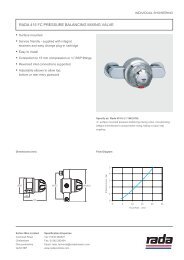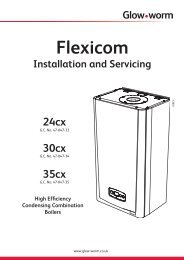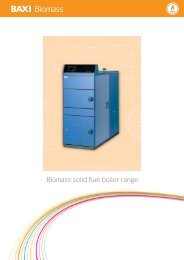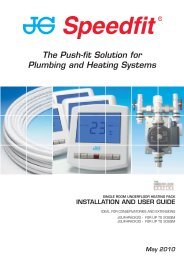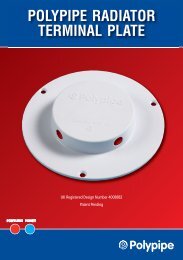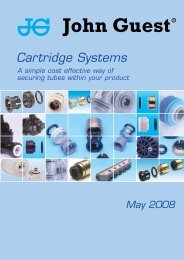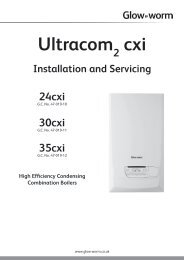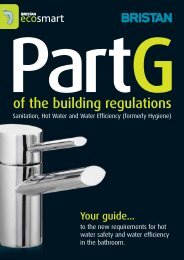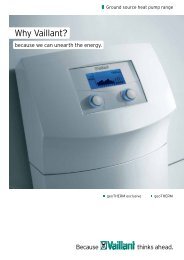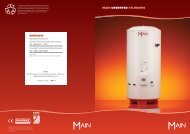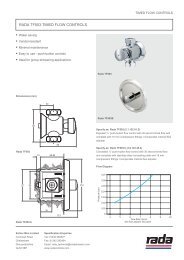Hep20 Technical Handbook
Hep20 Technical Handbook
Hep20 Technical Handbook
Create successful ePaper yourself
Turn your PDF publications into a flip-book with our unique Google optimized e-Paper software.
Hep 2<br />
O ® General Considerations<br />
Pressure Testing<br />
Installers should ensure that all non-<br />
Hep 2 O ® products can withstand<br />
the test pressure by checking with<br />
other relevant manufacturers.<br />
When testing Hep 2 O ® pipework<br />
systems, the recommended test<br />
pressure is:<br />
• for Hep 2 O® fittings with grab<br />
wedges – 1.5 times working<br />
pressure.<br />
• for Hep 2 O® grab ring and<br />
SlimLine fittings – a further test<br />
to 18 Bar.<br />
If the system contains any grab ring<br />
or SlimLine fittings the further test<br />
to a maximum of 18 Bar should<br />
always be undertaken.<br />
Care should be taken to disconnect<br />
any appliances or fittings that will<br />
not withstand, or will be damaged<br />
by, testing at 18 Bar.<br />
Gauge<br />
Valve 1<br />
Valve 2<br />
Figure 32<br />
Hep 2 O ® Pressure Testing Kit (HX81)<br />
Setting up the pressure test<br />
The testing procedure is set out<br />
below. The duration of the test<br />
should be not less than 1 hour in<br />
accordance with BS 6700.<br />
Pressure test procedure:<br />
1. Ensure that any non-Hep 2 O ®<br />
components in system will<br />
withstand test pressure.<br />
2. Blank off all open ends using<br />
Hep 2 O ® Blanking Pegs (HX44)<br />
or Blanking Plugs (HX41).<br />
3. Connect pressure hose to<br />
system at a convenient point<br />
using a demountable socket.<br />
4. Close Valve V2 and open Valve V1.<br />
5. Fill system to be tested with<br />
water ensuring that the system<br />
is completely full of water<br />
(purge all air).<br />
6. Raise pressure to test pressure<br />
and close Valve V1.<br />
7. At end of test duration, gently<br />
tap gauge with a finger (to<br />
ensure pointer is ‘free’). Read<br />
pressure on gauge. No<br />
appreciable drop in pressure<br />
should be noticed to indicate<br />
the system is watertight.<br />
8. Release Valve V1 and V2 to<br />
release pressure from system.<br />
Drain system if necessary.<br />
9. Replace cap and components in<br />
socket used for connection to<br />
test kit.<br />
10. Re-connect non-Hep 2 O ® parts<br />
of the system.<br />
It is important that this pressure<br />
testing procedure is not used as a<br />
substitute for making sure the<br />
correct insertion depth of the pipe is<br />
made into the fitting. The chevron<br />
marks on the pipe or a measured<br />
pencil mark should always be used.<br />
See page 6 for the correct method<br />
of connecting pipes to fittings.<br />
Painting Hep 2 O ®<br />
Hep 2 O ® can be painted where this<br />
is felt to be necessary, e.g. outdoors<br />
to protect the pipe from sunlight<br />
and the effects of ultra violet light.<br />
It is preferable when painting<br />
Hep 2 O ® to use emulsion paint.<br />
However, oil based gloss paint can<br />
be used in conjunction with<br />
undercoat. Cellulose based paints,<br />
paint strippers or thinners should<br />
not be used.<br />
Before painting, ensure all surfaces<br />
are clean, free of grease and dry.<br />
Freezing for Maintenance<br />
and System Modification<br />
Hep 2 O ® pipe can be frozen for<br />
maintenance or repairs without<br />
damage to the system. Freezing<br />
equipment manufacturers<br />
instructions should be followed.<br />
Freeze at a reasonable distance<br />
from where pipe is to be cut.<br />
Antifreeze<br />
Antifreezes based on Ethylene Glycol<br />
mixtures will not have an adverse<br />
effect on Hep 2 O ® . However if there<br />
is any doubt as to their suitability<br />
please contact the Hepworth<br />
Plumbing Products <strong>Technical</strong> Advisory<br />
Service for advice.<br />
Woodworm/Timber<br />
Treatment<br />
When treating timber for<br />
woodworm or timber rot, waterbased<br />
solutions are generally<br />
accepted. But care should be taken<br />
to protect and cover Hep 2 O ® pipe<br />
and fittings prior to any spraying.<br />
It is preferable to carry out any<br />
spraying prior to Hep 2 O ®<br />
installation.<br />
Solvent based treatments should<br />
not be used.<br />
For further information contact the<br />
Hepworth Plumbing Products<br />
<strong>Technical</strong> Advisory Service.<br />
82



